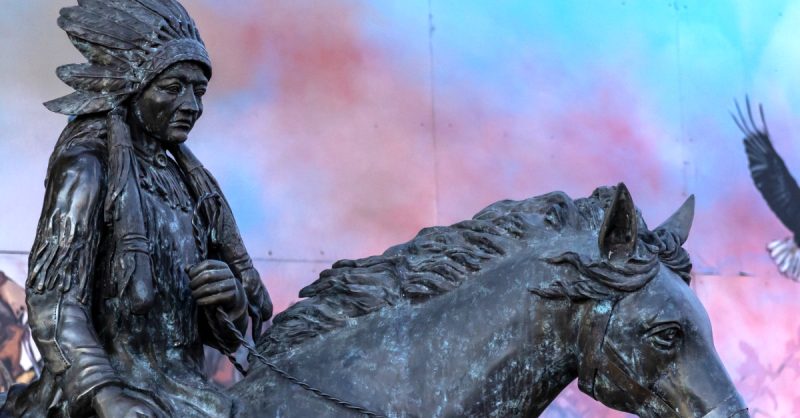The Indian tribes of Oklahoma possess a venerable and intricate history that dates back to pre-colonial times. Throughout the years, these tribes have faced myriad trials and tribulations, yet they have managed to establish themselves as integral and indispensable members of Oklahoma’s society.
In this article, we delve into the multifaceted and heterogeneous aspects of Indian tribes in Oklahoma, discussing both their historical and contemporary elements.
A Brief History
To begin with, the historical background of Indian tribes in Oklahoma is profoundly rich and multifarious. In 1830, the US government passed the Indian Removal Act, which mandated the forcible relocation of Native American tribes from their ancestral homelands to designated Indian Territory.
The Trail of Tears was an excruciating and horrendous consequence of this Act, as it involved the forcible displacement of the Cherokee Nation from their homeland in Georgia to Indian Territory, resulting in the deaths of thousands of Cherokee people.
Indian Territory was subsequently established in 1834, and it was eventually incorporated into the state of Oklahoma in 1907.
Largest Indian Tribes in Oklahoma
Furthermore, the Indian tribes in Oklahoma consist of numerous major tribes, with each one possessing its unique and idiosyncratic attributes. There are currently 39 federally recognized Indian tribes in Oklahoma, with the five largest tribes being the Cherokee Nation, Choctaw Nation, Chickasaw Nation, Creek Nation, and Seminole Nation.
- Oklahoma’s largest tribe, the Cherokee Nation, with 380,000 members.
- The third-largest US tribe, the Choctaw Nation, has nearly 200,000 members.
- The Chickasaw Nation, known for its financial success, has approximately 60,000 members.
- The Creek Nation has 80,000 members and a rich culture.
- The lively Seminole Nation has approximately 18,000 members.
Customs
Ultimately, Oklahoma American tribes’ diverse cultural practices are preserved in pottery, beading, and basketry. These arts are still practiced today. Oklahoma Indian tribes have distinctive rituals and traditions that make their culture unique and irreplaceable.
Pottery is a popular art form among many tribes in Oklahoma. The designs and patterns used in pottery often have significant cultural and spiritual meanings. Beadwork is another popular art form that is used to decorate clothing, accessories, and ceremonial items. Basketry is also significant to many tribes in Oklahoma, with different weaving techniques and patterns unique to each tribe.
Music and dance are also important cultural practices, with powwows being a significant part of Native American culture. Powwows are celebrations that bring together people from different tribes to dance, sing, and celebrate their heritage. These events often include traditional dances, music, and clothing that showcase the diverse cultural traditions of Native Americans.
Language is another vital aspect of Native American culture. Many tribes in Oklahoma have developed language preservation programs to keep their languages alive. These programs teach tribal languages to younger generations and help preserve the cultural traditions and values that are associated with each language.
Economic Impact of Indian Tribes in Oklahoma
Oklahoma’s economy benefits from Indian tribes. Many tribes make their money through casinos across the state. Gaming creates revenue for tribal initiatives and employs many tribal members.
Agriculture is another significant economic activity for Indian tribes in Oklahoma. Many tribes operate successful ranches and farms that contribute to the state’s economy. These operations provide jobs for tribal members and help sustain the tribe’s economic development.
Contemporary Issues Affecting Indian Tribes in Oklahoma
Healthcare is a significant issue affecting Indian tribes in Oklahoma. The Indian Health Service provides healthcare to many tribes, but the quality of care is often subpar due to a lack of resources and funding. Many tribes have developed their own healthcare systems to address this issue.
Oklahoma tribes also struggle with education. Rural tribal members lack proper education. The federal government owes Native American pupils an education, but it hasn’t always done so.
Oklahoma Indian tribes value sovereignty and self-determination. Tribal sovereignty is the right of tribes to rule themselves. Tribes have the right to self-determination in politics, economics, and culture.
Conclusion
In conclusion, Oklahoma’s Indian tribes celebrate their rich history and culture. These tribes have shaped Oklahoma’s economy and civilization. These tribes still face modern challenges like healthcare, education, and sovereignty, requiring ongoing support and lobbying.
FAQs
How Many Indian Tribes Are in Oklahoma?
There are currently 39 federally recognized Indian tribes in Oklahoma. The Cherokee Nation is the largest tribe in Oklahoma, with over 380,000 enrolled members.
How do Indian Tribes in Oklahoma Generate Revenue?
Indian tribes in Oklahoma generate revenue through various means, including the gaming industry and agriculture.
What is the Indian Health Service and How Does it Help Oklahoma Tribes?
The Indian Health Service is a federal agency that provides healthcare to Native Americans. Many tribes in Oklahoma rely on the Indian Health Service for healthcare services.
How Are the Rights of Native Tribes Protected in Oklahoma?
The Indian Self-Determination and Education Assistance Act and Indian Gaming Regulation Act protect Oklahoma Indian tribes’ rights. These rules help Indian tribes make economic, social, and cultural decisions.
What is the Impact of Indian Tribes on Oklahoma’s Culture?
Oklahoma’s rich culture is influenced by Indigenous tribes. The state’s diverse people and traditions are impacted by Native American culture.
What is the Relationship Between Indian Tribes and the State Government of Oklahoma?
History and current events have affected the relationship between Oklahoma Native tribes and the state government. Several tribes have their own governments and some autonomy, but the state must provide services to Native People.
How Can People Support Indian Tribes in Oklahoma?
Supporting Oklahoma Native tribes includes patronizing tribal businesses and attending cultural activities. Native American healthcare, education, and sovereignty programs must be supported.
What is the Role of Traditional Knowledge in Indian Tribes in Oklahoma?
Oklahoma Indian tribes depend on traditional knowledge. From traditional skills and crafts to spiritual beliefs and rituals, this knowledge is passed down.
What is the Future of Indian Tribes in Oklahoma?
Native tribes in Oklahoma’s future depends on their capacity to maintain their culture and autonomy. Native People in Oklahoma and elsewhere face numerous obstacles, but a resilient group is trying to preserve their culture and secure a brighter future.









